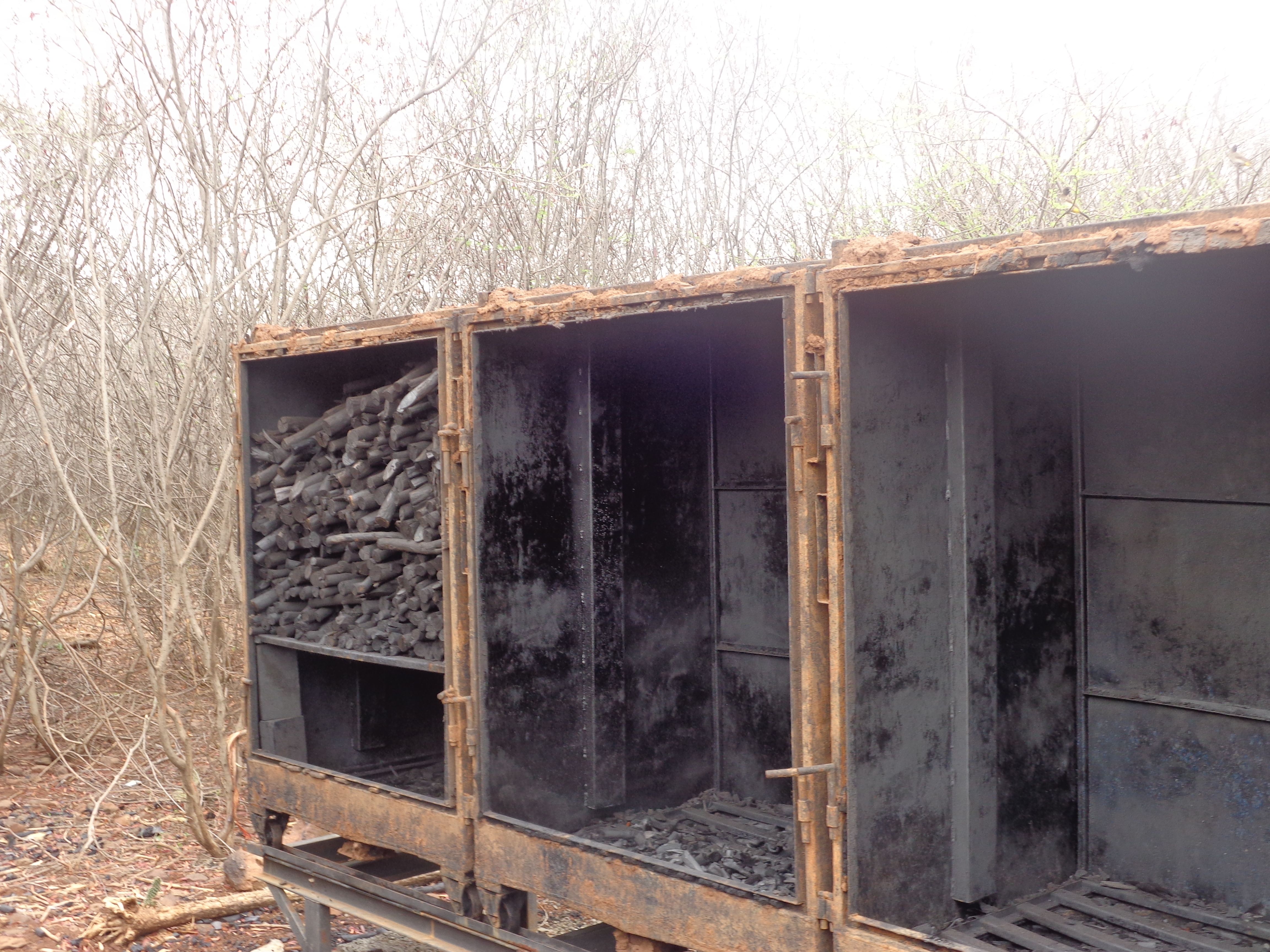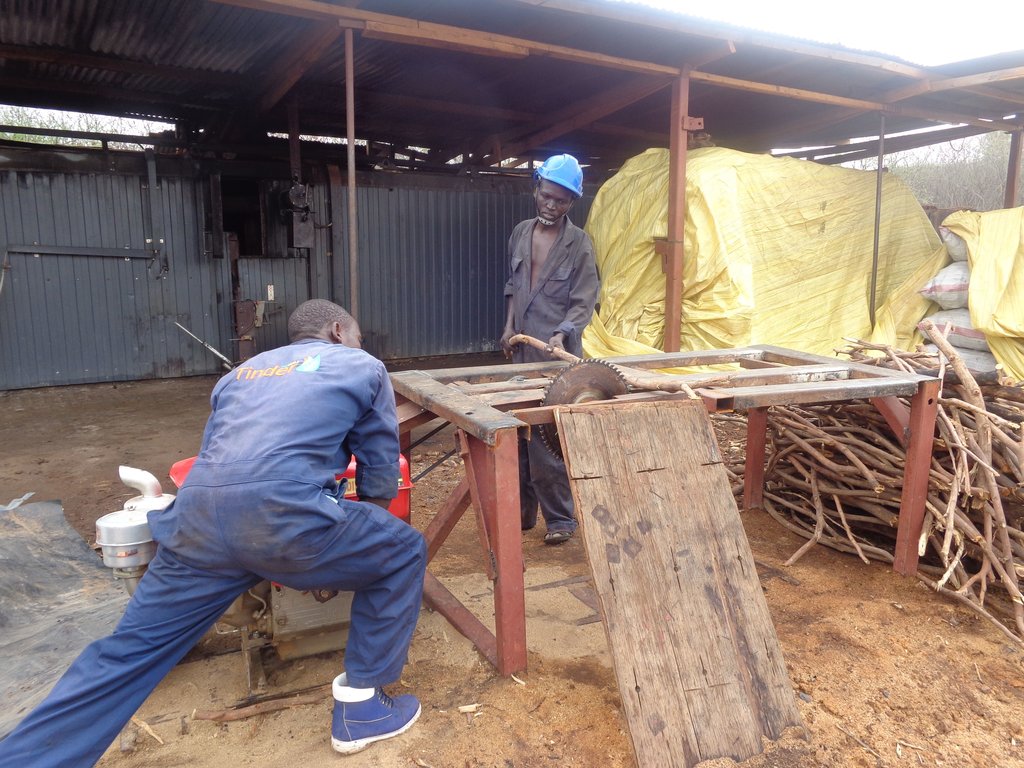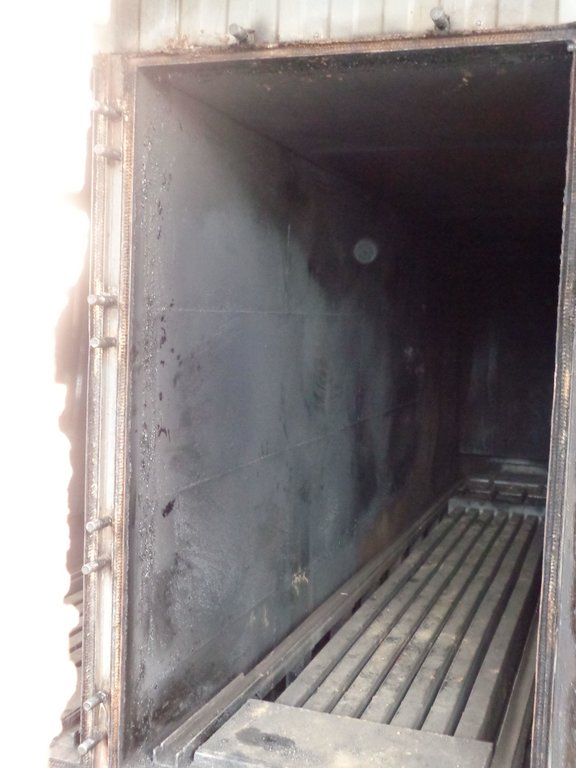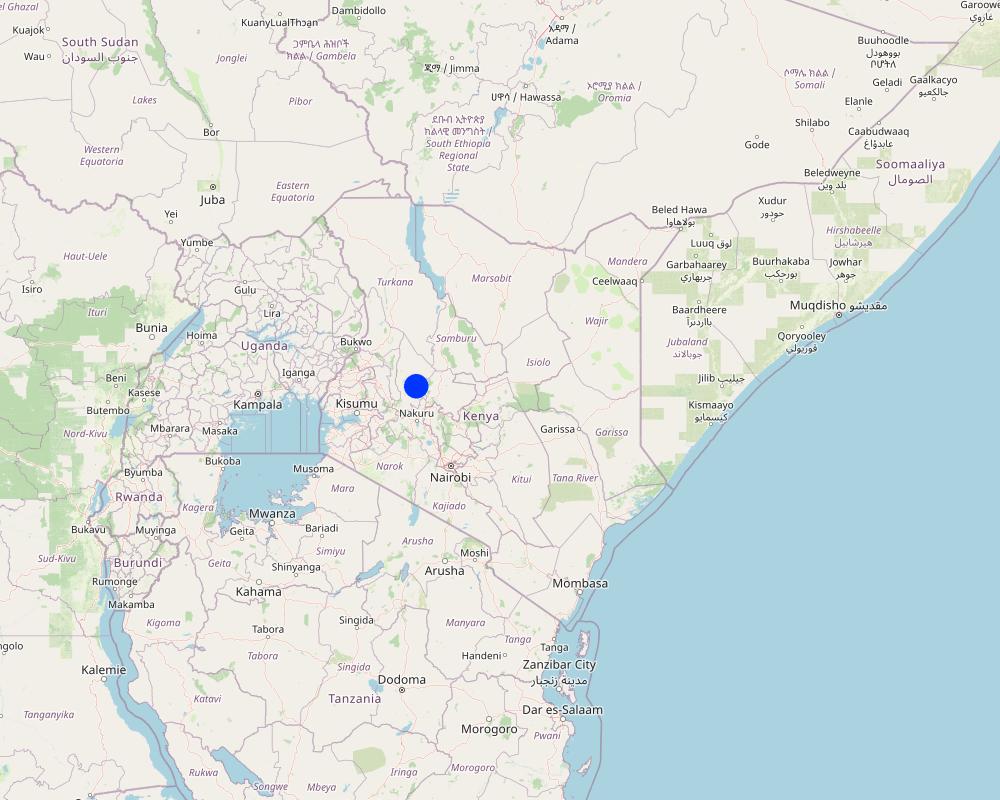Utilisation of invasive species biomass for charcoal production [เคนยา]
- ผู้สร้างสรรค์:
- การอัพเดท:
- ผู้รวบรวม: Beatrice Otieno
- ผู้เรียบเรียง: Albrecht Ehrensperger, Christian Hergarten
- ผู้ตรวจสอบ: Ross Shackleton
Utilisation of invasive species biomass for charcoal production
technologies_3475 - เคนยา
ดูส่วนย่อย
ขยายทั้งหมด ย่อทั้งหมด1. ข้อมูลทั่วไป
1.2 รายละเอียดที่ติดต่อได้ของผู้รวบรวมและองค์กรที่เกี่ยวข้องในการประเมินและการจัดเตรียมทำเอกสารของเทคโนโลยี
วิทยากรหลัก
ผู้ใช้ที่ดิน:
ชื่อของโครงการซึ่งอำนวยความสะดวกในการทำเอกสารหรือการประเมินเทคโนโลยี (ถ้าเกี่ยวข้อง)
R4D Woody Weedsชื่อขององค์กรซึ่งอำนวยความสะดวกในการทำเอกสารหรือการประเมินเทคโนโลยี (ถ้าเกี่ยวข้อง)
CDE Centre for Development and Environment (CDE Centre for Development and Environment) - สวิตเซอร์แลนด์1.3 เงื่อนไขการใช้ข้อมูลที่ได้บันทึกผ่านทาง WOCAT
วันที่เก็บรวบรวมข้อมูล(ภาคสนาม) :
13/03/2018
ผู้รวบรวมและวิทยากรหลักยอมรับเงื่อนไขเกี่ยวกับการใช้ข้อมูลที่ถูกบันทึกผ่านทาง WOCAT:
ใช่
1.4 การเปิดเผยเรื่องความยั่งยืนของเทคโนโลยีที่ได้อธิบายไว้
แสดงความคิดเห็น:
The main objective of the technology was to minimize environmental pollution through environmentally friendly production processes, uphold preservation of threatened indigenous species by using invasive Prosopis juliflora as a feed stock thereby reducing its woody biomass as well as controlling its spread. However, it is reported that such extractions of the tree parts for charcoal production purposes enhances coppicing, facilitating further invasion. Although disputed by recent research work, the potentiality of control through utilization in managing Prosopis spread is still uncertain. However, there are chances that unless integrated by other management strategies involving active land restorative measures as documented in technologies 3444 and 3455, charcoal production may not sustainably control the spread of Prosopis juliflora.
2. การอธิบายลักษณะของเทคโนโลยี SLM
2.1 การอธิบายแบบสั้น ๆ ของเทคโนโลยี
คำจำกัดความของเทคโนโลยี:
Charcoal production from invasive Prosopis juliflora has several objectives. It has been promoted to control the spread and reduce the abundance of invasive Juliflora while generating income opportunities for poor rural households producing and selling charcoal. Wood pyrolysis is an efficient, environmentally friendly charcoal production technology through indirect heating of wood at high temperatures with the release of water vapor.
2.2 การอธิบายแบบละเอียดของเทคโนโลยี
คำอธิบาย:
The use of invasive Prosopis wood for charcoal production is intended to control its spread, create space for agricultural or grazing activities and restore degraded land.
Tinder Eco fuels limited is a private company whose aim is to efficiently produce charcoal through modern, environmental friendly techniques using the ‘EURO’ line charcoal kilns. Approximately 60 tons of invasive Prosopis wood are collected weekly, ejecting an estimate of Ksh. 400,000 weekly income to the local community.
Prosopis, the only tree in Baringo permitted for charcoal production is cut by land users and dried for three days to lower its water content before being transported to the production firm. The trees are then weighed and cut into 15 cm lengths, a corresponding dimension of the loading and offloading trolleys. In the carbonizing chambers, the raw materials are subjected to indirect burning and consequent cooling by pyrolysis gas heated at 250 – 500 degree celcius, a process that takes 8-16 hours. Operations in the chambers are controlled and regulated by an assembly of sensors. Ready charcoal is offloaded into a winch which is covered and sealed by a sandy-clay mixture for further cooling to prevent combustion.
Land users prefer this technology to the traditional one as it is more efficient with a guaranteed income from the sale of Prosopis wood. The carbonization process is fine-tuned, minimizing smoke production and the number of point sources of pollution through household-based traditional charcoal production. A steady production process that is resilient to rainy seasons ensures market readiness and reduces price fluctuations. Clearing the land from invasive Prosopis increases the land's economic and ecological value and the provision of mutliple ecosystem services relevant for local people.
2.3 รูปภาพของเทคโนโลยี
2.5 ประเทศภูมิภาค หรือสถานที่ตั้งที่เทคโนโลยีได้นำไปใช้และได้รับการครอบคลุมโดยการประเมินนี้
ประเทศ:
เคนยา
ภูมิภาค/รัฐ/จังหวัด:
Baringo County
ข้อมูลจำเพาะเพิ่มเติมของสถานที่ตั้ง :
Marigat Sub-County
แสดงความคิดเห็น:
No precise location, rather indication of area where the technology is being implemented.
Map
×2.6 วันที่การดำเนินการ
ระบุปีที่ใช้:
2015
2.7 คำแนะนำของเทคโนโลยี
ให้ระบุว่าเทคโนโลยีถูกแนะนำเข้ามาอย่างไร:
- ทางโครงการหรือจากภายนอก
ความคิดเห็น (ประเภทของโครงการ เป็นต้น) :
The technology was established by a private company to transform traditional to a modern environmentally friendly charcoal production technique while advocating for the protection of indigenous tree species threatened by invasive Prosopis.
3. การจัดประเภทของเทคโนโลยี SLM
3.1 วัตถุประสงค์หลักของเทคโนโลยี
- ปรับปรุงการผลิตให้ดีขึ้น
- ลด ป้องกัน ฟื้นฟู การเสื่อมโทรมของที่ดิน
- อนุรักษ์ระบบนิเวศน์
- รักษาสภาพหรือปรับปรุงความหลากหลายทางชีวภาพ
- ชะลอการเปลี่ยนแปลงภูมิอากาศของโลกและผลกระทบ
- สร้างผลกระทบทางด้านเศรษฐกิจที่เป็นประโยชน์
- สร้างผลกระทบทางด้านสังคมที่เป็นประโยชน์
- enhance provision of multiple ecosystem services
3.2 ประเภทของการใช้ที่ดินในปัจจุบันที่ได้นำเทคโนโลยีไปใช้

ป่า/พื้นที่ทำไม้
ป่ากึ่งธรรมชาติ / พื้นที่ทำไม้:
- การตัดไม้ที่มีคัดเลือก (Selective felling)
- การเอาไม้ที่ตายแล้วออกไปหรือการตัดแต่งกิ่ง
ผลิตภัณฑ์และบริการ:
- ไม้ที่นำมาทำเป็นเชื้อเพลิง
แสดงความคิดเห็น:
The cleared lands, unless located within the irrigated farmlands where cultivation usually follows, are usually left idle allowing Prosopis to coppice and the harvesting cycle continues.
ถ้าการใช้ที่ดินมีการเปลี่ยนแปลงเนื่องมาจากการนำเทคโนโลยีไปปฏิบัติใช้ ให้ระบุการใช้ที่ดินก่อนนำเทคโนโลยีไปปฏิบัติใช้:
The challenge with charcoal production from prosopis is that without supporting measures and interventions, prosopis may not be reduced. Therefore it is very important to define a clear goal before implementing the technology. If complete eradication of prosopis is the goal, then charcoal production from prosopis can only be a technology to cover the transition from prosopis to e.g. agriculture or pasture.
3.3 ข้อมูลเพิ่มเติมเกี่ยวกับการใช้ที่ดิน
การใช้น้ำของที่ดินที่มีการใช้เทคโนโลยีอยู่:
- จากน้ำฝน
ระบุ:
Prosopis is an evergreen tree and easily regenerates and becomes invasive without any human intervention. Cutting of stems or uprooting without a restorative measure in place facilitates their ability to coppice and re-germinate due to the resistant nature of their seeds.
3.4 กลุ่ม SLM ที่ตรงกับเทคโนโลยีนี้
- การจัดการป่าธรรมชาติและกึ่งธรรมชาติ
- การจัดการปศุสัตว์และทุ่งหญ้าเลี้ยงสัตว์
- ประสิทธิภาพด้านพลังงาน
3.5 กระจายตัวของเทคโนโลยี
ระบุการกระจายตัวของเทคโนโลยี:
- ใช้ ณ จุดที่เฉพาะเจาะจงหรือเน้นไปยังบริเวณพื้นที่ขนาดเล็ก
แสดงความคิดเห็น:
While charcoal production is most efficiently achieved in a centrally located production facility, the woody material from invasive Prosopis typically originates from heavily invaded areas easily accessible and close to the prodcution facility. The size of the facility's catchment area typically depends on the level of invasion.
3.6 มาตรการ SLM ที่ประกอบกันเป็นเทคโนโลยี

มาตรการอนุรักษ์ด้วยวิธีพืช
- V3: กำจัดพืชออกให้หมด
- V4: การแทนที่หรือการนำพันธุ์ต่างถิ่น/ที่รุกล้ำเข้ามา ออกไปจากพื้นที่

มาตรการอนุรักษ์ด้วยการจัดการ
- M5: การควบคุมหรือการเปลี่ยนแปลงขององค์ประกอบของชนิดพันธุ์
3.7 รูปแบบหลักของการเสื่อมโทรมของที่ดินที่ได้รับการแก้ไขโดยเทคโนโลยี

การเสื่อมโทรมของดินทางด้านชีวภาพ
- Bs (Quality and species composition): องค์ประกอบหรือความหลากหลายทางคุณภาพและชนิดพันธุ์ลดลง
3.8 การป้องกัน การลดลง หรือการฟื้นฟูความเสื่อมโทรมของที่ดิน
ระบุเป้าหมายของเทคโนโลยีกับความเสื่อมโทรมของที่ดิน:
- ลดความเสื่อมโทรมของดิน
แสดงความคิดเห็น:
If accompanying measures are put in place, then the technology can also contribute to restore and rehabilitate degraded land.
4. ข้อมูลจำเพาะด้านเทคนิค กิจกรรมการนำไปปฏิบัติใช้ ปัจจัยนำเข้า และค่าใช้จ่าย
4.1 แบบแปลนทางเทคนิคของเทคโนโลยี
4.3 ข้อมูลทั่วไปเกี่ยวกับการคำนวณปัจจัยนำเข้าและค่าใช้จ่าย
ให้ระบุว่าค่าใช้จ่ายและปัจจัยนำเข้าได้รับการคำนวณอย่างไร:
- ต่อหน่วยเทคโนโลยี
โปรดระบุหน่วย:
Charcoal production plant
ระบุปริมาตร ความยาว เป็นต้น (ถ้าเกี่ยวข้อง):
1
ระบุอัตราแลกเปลี่ยนจากดอลลาร์สหรัฐเป็นสกุลเงินท้องถิ่น (ถ้าเกี่ยวข้อง) คือ 1 เหรียญสหรัฐ =:
100.0
4.4 กิจกรรมเพื่อการจัดตั้ง
| กิจกรรม | ประเภทของมาตรการ | ช่วงเวลาดำเนินการ | |
|---|---|---|---|
| 1. | Construction | ด้วยโครงสร้าง | once during the plant establishment |
| 2. | Machine installation | ด้วยโครงสร้าง | once during the plant establishment |
4.5 ค่าใช้จ่ายของปัจจัยนำเข้าที่จำเป็นสำหรับการจัดตั้ง
| ปัจจัยนำเข้า | หน่วย | ปริมาณ | ค่าใช้จ่ายต่อหน่วย | ค่าใช้จ่ายทั้งหมดต่อปัจจัยนำเข้า | %ของค่าใช้จ่ายที่ก่อให้เกิดขึ้นโดยผู้ใช้ที่ดิน | |
|---|---|---|---|---|---|---|
| แรงงาน | machine installation (35% of machine cost) | Men | 14.0 | 50000.0 | 700000.0 | 100.0 |
| อุปกรณ์ | ‘EURO’ line charcoal kiln | a set | 1.0 | 2000000.0 | 2000000.0 | 100.0 |
| อุปกรณ์ | welding machine | unit | 1.0 | 22000.0 | 22000.0 | 100.0 |
| อุปกรณ์ | cutting disk | unit | 1.0 | 1800.0 | 1800.0 | 100.0 |
| วัสดุสำหรับก่อสร้าง | Operations' shade | building | 1.0 | 100000.0 | 100000.0 | 100.0 |
| อื่น ๆ | business operations permit | operations permit | 1.0 | 20000.0 | 20000.0 | 100.0 |
| ค่าใช้จ่ายทั้งหมดของการจัดตั้งเทคโนโลยี | 2843800.0 | |||||
4.6 การบำรุงรักษาสภาพหรือกิจกรรมที่เกิดขึ้นเป็นประจำ
| กิจกรรม | ประเภทของมาตรการ | ช่วงระยะเวลา/ความถี่ | |
|---|---|---|---|
| 1. | Transportation of wood from land users | ด้วยการจัดการ | daily |
| 2. | Cutting of wood | ด้วยโครงสร้าง | daily |
| 3. | Loading into carbonizers | ด้วยโครงสร้าง | daily |
| 4. | Packing of ready charcoal | ด้วยโครงสร้าง | daily |
4.7 ค่าใช้จ่ายของปัจจัยนำเข้าและกิจกรรมที่เกิดขึ้นเป็นประจำที่ต้องการการบำรุงรักษา (ต่อปี)
| ปัจจัยนำเข้า | หน่วย | ปริมาณ | ค่าใช้จ่ายต่อหน่วย | ค่าใช้จ่ายทั้งหมดต่อปัจจัยนำเข้า | %ของค่าใช้จ่ายที่ก่อให้เกิดขึ้นโดยผู้ใช้ที่ดิน | |
|---|---|---|---|---|---|---|
| แรงงาน | Technical employees | monthly salary | 12.0 | 60000.0 | 720000.0 | 100.0 |
| แรงงาน | Casual workers | monthly salary | 3.0 | 20000.0 | 60000.0 | 100.0 |
| วัสดุด้านพืช | wood | tonne | 3360.0 | 1200.0 | 4032000.0 | 100.0 |
| วัสดุด้านพืช | water | |||||
| อื่น ๆ | permit | 1.0 | 20000.0 | 20000.0 | 100.0 | |
| อื่น ๆ | electicity | amperes | 180.0 | 267.0 | 48060.0 | 100.0 |
| อื่น ๆ | water | litres | 54000.0 | 0.8 | 43200.0 | 100.0 |
| ค่าใช้จ่ายทั้งหมดของการบำรุงรักษาสภาพเทคโนโลยี | 4923260.0 | |||||
4.8 ปัจจัยสำคัญที่สุดที่มีผลกระทบต่อค่าใช้จ่าย
ปัจจัยสำคัญที่สุดที่มีผลกระทบต่อค่าใช้จ่ายต่างๆ:
Weather conditions may affect transportation of wood due to poor rural road condition
Power outages
5. สิ่งแวดล้อมทางธรรมชาติและของมนุษย์
5.1 ภูมิอากาศ
ฝนประจำปี
- < 250 ม.ม.
- 251-500 ม.ม.
- 501-750 ม.ม.
- 751-1,000 ม.ม.
- 1,001-1,500 ม.ม.
- 1,501-2,000 ม.ม.
- 2,001-3,000 ม.ม.
- 3,001-4,000 ม.ม.
- > 4,000 ม.ม.
ระบุปริมาณน้ำฝนเฉลี่ยรายปี (ถ้ารู้) :หน่วย ม.ม.
671.00
เขตภูมิอากาศเกษตร
- กึ่งแห้งแล้ง
Average annual rainfall in mm: 671.0
Rainfall is characterized by seasonal and annual uctuations
The area is in a semi-arid zone with temperatures ranging
between 16 to 36 degrees, averagely 24.6 degrees, accompanied
by high evaporation rates of up to 6mm. It experiences an
average rainfall of 671 mm annually which are very erratic.
5.2 สภาพภูมิประเทศ
ค่าเฉลี่ยความลาดชัน:
- ราบเรียบ (0-2%)
- ลาดที่ไม่ชัน (3-5%)
- ปานกลาง (6-10%)
- เป็นลูกคลื่น (11-15%)
- เป็นเนิน (16-30%)
- ชัน (31-60%)
- ชันมาก (>60%)
ธรณีสัณฐาน:
- ที่ราบสูง/ที่ราบ
- สันเขา
- ไหล่เขา
- ไหล่เนินเขา
- ตีนเนิน
- หุบเขา
ระดับความสูง:
- 0-100 เมตร
- 101-500 เมตร
- 501-1,000 เมตร
- 1,001-1,500 เมตร
- 1,501-2,000 เมตร
- 2,001-2,500 เมตร
- 2,501-3,000 เมตร
- 3,001-4,000 เมตร
- > 4,000 เมตร
ให้ระบุถ้าเทคโนโลยีได้ถูกนำไปใช้:
- ไม่เกี่ยวข้อง
5.3 ดิน
ค่าเฉลี่ยความลึกของดิน:
- ตื้นมาก (0-20 ซ.ม.)
- ตื้น (21-50 ซ.ม.)
- ลึกปานกลาง (51-80 ซ.ม.)
- ลึก (81-120 ซ.ม.)
- ลึกมาก (>120 ซ.ม.)
เนื้อดิน (ดินชั้นบน):
- ปานกลาง (ดินร่วน ทรายแป้ง)
เนื้อดินล่าง (> 20 ซ.ม.ต่ำจากผิวดิน):
- ปานกลาง (ดินร่วน ทรายแป้ง)
อินทรียวัตถุในดิน:
- ต่ำ (<1%)
5.4 ความเป็นประโยชน์และคุณภาพของน้ำ
น้ำไหลบ่าที่ผิวดิน:
ดี
คุณภาพน้ำ (ที่ยังไม่ได้บำบัด):
เป็นน้ำเพื่อการดื่มที่ไม่ดี (จำเป็นต้องได้รับการบำบัด)
กำลังเกิดน้ำท่วมในพื้นที่หรือไม่:
ใช่
5.5 ความหลากหลายทางชีวภาพ
ความหลากหลายทางชนิดพันธุ์:
- ต่ำ
ความหลากหลายของแหล่งที่อยู่:
- ต่ำ
ความคิดเห็นและข้อมูลจำเพาะเพิ่มเติมของความหลากหลายทางชีวภาพ:
Marigat is heavily invaded by Prosopis which have out competed native vegetation and grasses, threatening biodiversity.
5.6 ลักษณะของผู้ใช้ที่ดินที่นำเทคโนโลยีไปปฏิบัติใช้
อยู่กับที่หรือเร่ร่อน:
- อยู่กับที่
แนวทางการตลาดของระบบการผลิต:
- ผสม (การเลี้ยงชีพ/ทำการค้า)
รายได้ที่มาจากนอกฟาร์ม:
- 10-50% ของรายได้ทั้งหมด
ระดับของความมั่งคั่งโดยเปรียบเทียบ:
- จน
เป็นรายบุคคล/ครัวเรือน:
- เป็นรายบุคคล/ครัวเรือน
- กลุ่ม/ชุมชน
ระดับของการใช้เครื่องจักรกล:
- งานที่ใช้แรงกาย
- การใช้เครื่องจักรหรือเครื่องยนต์
เพศ:
- หญิง
- ชาย
อายุของผู้ใช้ที่ดิน:
- ผู้เยาว์
- วัยกลางคน
5.7 พื้นที่เฉลี่ยของที่ดินที่เป็นเจ้าของหรือเช่าโดยผู้ใช้ที่ดินที่นำเทคโนโลยีไปปฏิบัติใช้
- < 0.5 เฮกตาร์
- 0.5-1 เฮกตาร์
- 1-2 เฮกตาร์
- 2-5 เฮกตาร์
- 5-15 เฮกตาร์
- 15-50 เฮกตาร์
- 50-100 เฮกตาร์
- 100-500 เฮกตาร์
- 500-1,000 เฮกตาร์
- 1,000-10,000 เฮกตาร์
- >10,000 เฮกตาร์
พิจารณาว่าเป็นขนาดเล็ก กลาง หรือขนาดใหญ่ (ซึ่งอ้างอิงถึงบริบทระดับท้องถิ่น):
- ขนาดกลาง
5.8 กรรมสิทธิ์ในที่ดิน สิทธิในการใช้ที่ดินและสิทธิในการใช้น้ำ
กรรมสิทธิ์ในที่ดิน:
- เป็นแบบชุมชนหรือหมู่บ้าน
สิทธิในการใช้ที่ดิน:
- เกี่ยวกับชุมชน (ถูกจัดระเบียบ)
สิทธิในการใช้น้ำ:
- เข้าถึงได้แบบเปิด (ไม่ได้จัดระเบียบ)
5.9 การเข้าถึงบริการและโครงสร้างพื้นฐาน
สุขภาพ:
- จน
- ปานกลาง
- ดี
การศึกษา:
- จน
- ปานกลาง
- ดี
ความช่วยเหลือทางด้านเทคนิค:
- จน
- ปานกลาง
- ดี
การจ้างงาน (เช่น ภายนอกฟาร์ม):
- จน
- ปานกลาง
- ดี
ตลาด:
- จน
- ปานกลาง
- ดี
พลังงาน:
- จน
- ปานกลาง
- ดี
ถนนและการขนส่ง:
- จน
- ปานกลาง
- ดี
น้ำดื่มและการสุขาภิบาล:
- จน
- ปานกลาง
- ดี
บริการด้านการเงิน:
- จน
- ปานกลาง
- ดี
6. ผลกระทบและสรุปคำบอกกล่าว
6.1 ผลกระทบในพื้นที่ดำเนินการ (On-site) จากการใช้เทคโนโลยี
ผลกระทบทางด้านเศรษฐกิจและสังคม
การผลิต
การผลิตพืชผล
คุณภาพพืชผล
การผลิตพืชที่ใช้เลี้ยงปศุสัตว์
คุณภาพพืชที่ใช้เลี้ยงปศุสัตว์
การผลิตสัตว์
การผลิตไม้
คุณภาพป่า /พื้นที่ทำไม้
แสดงความคิดเห็น/ระบุ:
Coppicing of the cut trees slightly increases the woody biomass of Prosopis weed.
ความหลากหลายของผลิตภัณฑ์
การจัดการที่ดิน
แสดงความคิดเห็น/ระบุ:
Land management is simplified on condition that other restorative measures are incorporated
รายได้และค่าใช้จ่าย
รายได้จากฟาร์ม
ความหลากหลายของแหล่งผลิตรายได้
ความเหลื่อมล้ำทางเศรษฐกิจ
ภาระงาน
ผลกระทบด้านสังคมวัฒนธรรมอื่น ๆ
สถาบันของชุมชน
แสดงความคิดเห็น/ระบุ:
Charcoal production has led to the establishment of community-based charcoal production associations which regulate all transactions relating to charcoal production, marketing and sale.
SLM หรือความรู้เรื่องความเสื่อมโทรมของที่ดิน
แสดงความคิดเห็น/ระบุ:
Am initial directive restricting charcoal production to Prosopis trees enhanced the protection of indigenous trees , creating awareness on the need for their management.
6.2 ผลกระทบนอกพื้นที่ดำเนินการ (Off-site) จากการใช้เทคโนโลยี
ผลกระทบของก๊าซเรือนกระจก
6.3 การเผชิญและความตอบสนองของเทคโนโลยีต่อการเปลี่ยนแปลงสภาพภูมิอากาศที่ค่อยเป็นค่อยไป และสภาพรุนแรงของภูมิอากาศ / ภัยพิบัติ (ที่รับรู้ได้โดยผู้ใช้ที่ดิน)
การเปลี่ยนแปลงสภาพภูมิอากาศที่ค่อยเป็นค่อยไป
การเปลี่ยนแปลงสภาพภูมิอากาศที่ค่อยเป็นค่อยไป
| ฤดู | ประเภทของการเปลี่ยนแปลงสภาพภูมิอากาศที่ค่อยเป็นค่อยไป และสภาพรุนแรงของภูมิอากาศ | เทคโนโลยีมีวิธีการรับมืออย่างไร | |
|---|---|---|---|
| ฝนประจำปี | เพิ่มขึ้น | ปานกลาง |
สภาพรุนแรงของภูมิอากาศ (ภัยพิบัติ)
ภัยพิบัติจากน้ำ
| เทคโนโลยีมีวิธีการรับมืออย่างไร | |
|---|---|
| น้ำท่วมตามปกติ (แม่น้ำ) | ไม่ค่อยดี |
6.4 การวิเคราะห์ค่าใช้จ่ายและผลประโยชน์ที่ได้รับ
ผลประโยชน์ที่ได้รับเปรียบเทียบกับค่าใช้จ่ายในการจัดตั้งเป็นอย่างไร (จากมุมมองของผู้ใช้ที่ดิน)
ผลตอบแทนระยะสั้น:
ด้านลบอย่างมาก
ผลตอบแทนระยะยาว:
ด้านบวก
ผลประโยชน์ที่ได้รับเปรียบเทียบกับค่าใช้จ่ายในการบำรุงรักษาหรือต้นทุนที่เกิดขึ้นซ้ำอีก เป็นอย่างไร (จากมุมมองของผู้ใช้ที่ดิน)
ผลตอบแทนระยะสั้น:
ด้านลบ
ผลตอบแทนระยะยาว:
ด้านบวกอย่างมาก
6.5 การปรับตัวของเทคโนโลยี
- ครั้งเดียวหรือเป็นการทดลอง
จากทั้งหมดที่ได้รับเทคโนโลยีเข้ามามีจำนวนเท่าใดที่ทำแบบทันที โดยไม่ได้รับการจูงใจด้านวัสดุหรือการเงินใด ๆ:
- 90-100%
แสดงความคิดเห็น:
Although traditional charcoal production is widespread among the households in the community, the eco-friendly power generation technology has been adopted by only one private farm due to the initial high cost of acquiring machinery to carry out the operations
6.6 การปรับตัว
เทคโนโลยีได้รับการปรับเปลี่ยนเมื่อเร็วๆนี้ เพื่อให้ปรับตัวเข้ากับสภาพที่กำลังเปลี่ยนแปลงหรือไม่:
ไม่ใช่
6.7 จุดแข็ง / ข้อได้เปรียบ / โอกาสของเทคโนโลยี
| จุดแข็ง / ข้อได้เปรียบ / โอกาสในทัศนคติของผู้ใช้ที่ดิน |
|---|
| Fast and efficient means of producing charcoal compared to traditional technologies as it produced 3 times the amount of charcoal from the same quantity of wood within 16 hours compared to 1 week. |
| Readily available raw materials at affordable price |
| A reliable source of income to the community members |
| จุดแข็ง / ข้อได้เปรียบ / โอกาสในทัศนคติของผู้รวบรวมหรือวิทยากรหลัก |
|---|
| Environmentally friendly technology of utilizing Prosopis weed with reduced number of point sources for air pollution. |
| Improved community well-being through assured high income from the sale of Prosopis wood compared to their initial practice of tideous traditional charcoal burning and sale. |
| Potentiality in sustainably managing Prosopis / invasive species if integrated with other restorative land management strategies. |
6.8 จุดอ่อน / ข้อเสียเปรียบ / ความเสี่ยงของเทคโนโลยีและวิธีการแก้ไข
| จุดอ่อน / ข้อเสียเปรียบ / ความเสี่ยงในทัศนคติของผู้ใช้ที่ดิน | มีวิธีการแก้ไขได้อย่างไร |
|---|---|
| Poor roads and power shortages during rainy seasons hinders transportation of wood and charcoal production processes as reliance on a fuel generator increases production costs | Improving the road network |
| Corruption and associated assault by police during transportation of charcoal to the market. | Establishment of transparent and clear laws on legal requirements related to charcoal production activities |
| Unsteady regulatory and policy frameworks disrupting charcoal production |
| จุดอ่อน / ข้อเสียเปรียบ / ความเสี่ยงในทัศนคติของผู้รวบรวมหรือวิทยากรหลัก | มีวิธีการแก้ไขได้อย่างไร |
|---|---|
| Unsustainability in controlling invasive species | Integration with other land restoration measures to control re-invasion. |
7. การอ้างอิงและการเชื่อมต่อ
7.1 วิธีการและแหล่งข้อมูล
- ไปเยี่ยมชมภาคสนาม การสำรวจพื้นที่ภาคสนาม
1
Tinder Eco-fuels Limited
- การสัมภาษณ์กับผู้ใช้ที่ดิน
3
7.2 การอ้างอิงถึงสิ่งตีพิมพ์
หัวข้อ, ผู้เขียน, ปี, หมายเลข ISBN:
Spatial Evolution of Prosopis Invasion and its Effects on LULC and Livelihoods in Baringo, Kenya. Mbaabu et al. 2019.
ชื่อเรื่อง ผู้เขียน ปี ISBN:
https://doi.org/10.3390/rs11101217
หัวข้อ, ผู้เขียน, ปี, หมายเลข ISBN:
Experimental prosopis management practices and grassland restoration in three Eastern African countries. Eschen et al, 2023.
ชื่อเรื่อง ผู้เขียน ปี ISBN:
https://doi.org/10.1186/s43170-023-00163-5
หัวข้อ, ผู้เขียน, ปี, หมายเลข ISBN:
Chapter 12. A REVIEW OF BEST MANAGEMENT PRACTICES FOR THE CONTROL OF INVASIVE PROSOPIS TREES
ชื่อเรื่อง ผู้เขียน ปี ISBN:
Forthcoming (Schaffner et al. 2024)
ลิงก์และโมดูล
ขยายทั้งหมด ย่อทั้งหมดลิงก์
ไม่มีลิงก์
โมดูล
ไม่มีโมดูล







